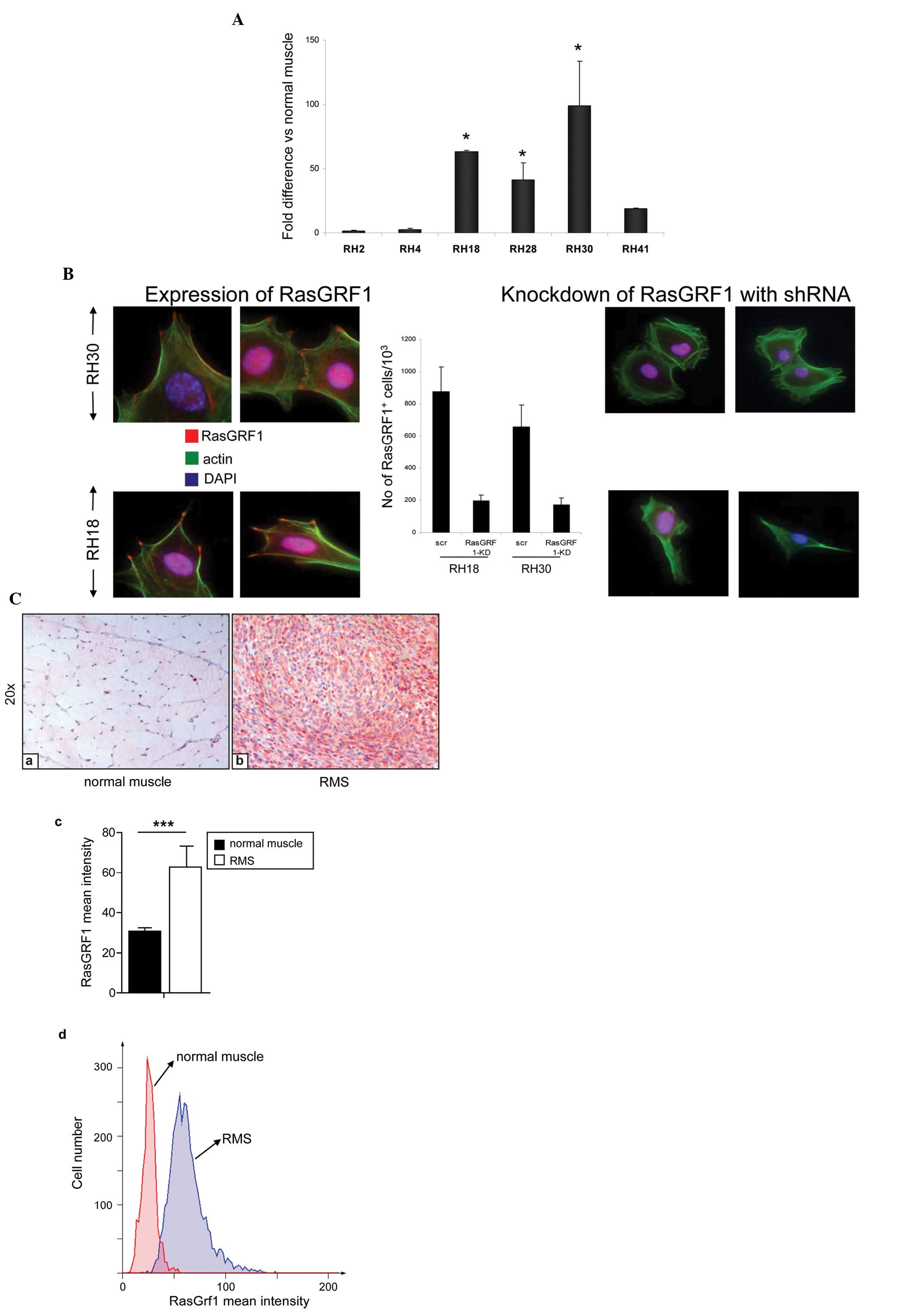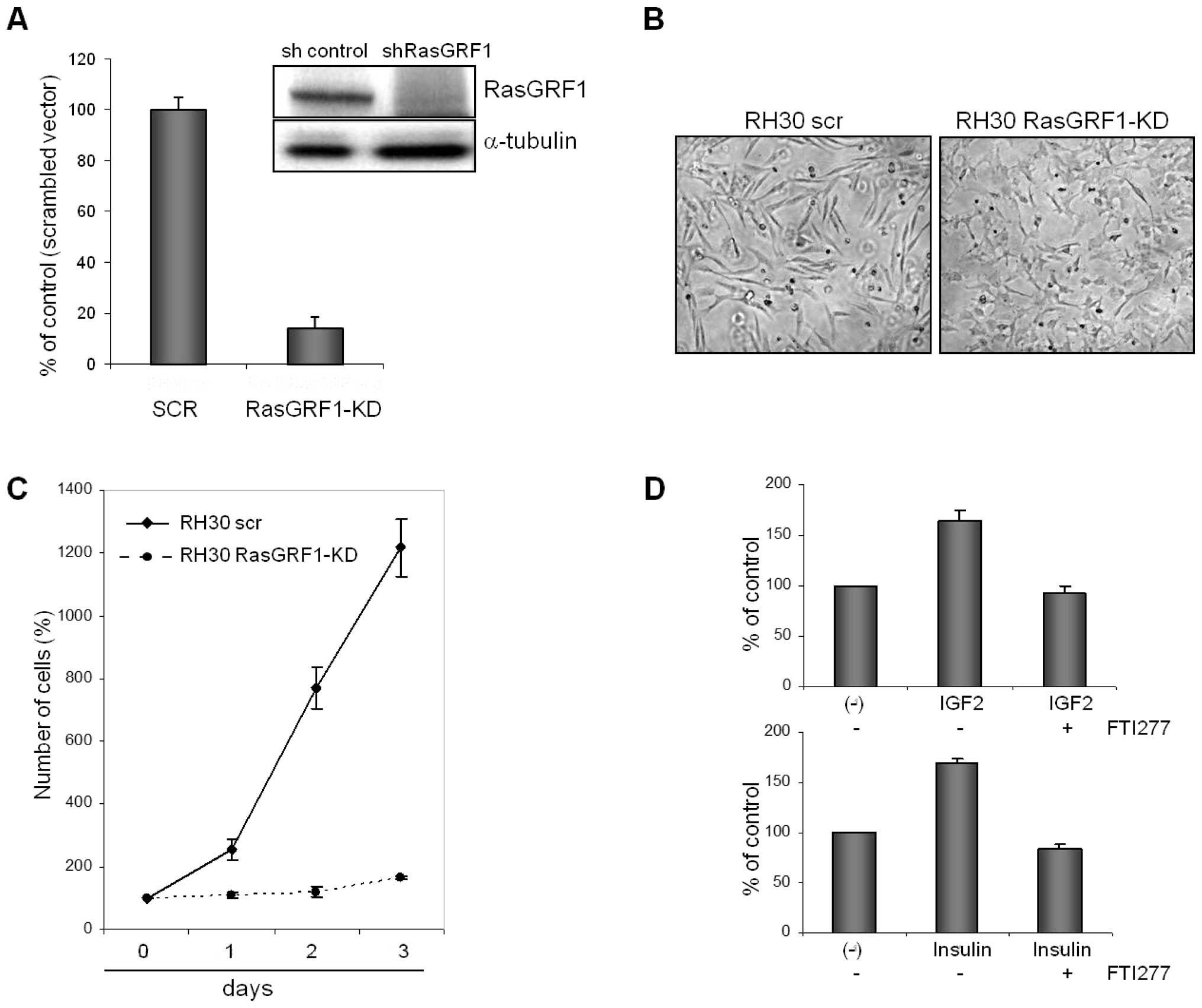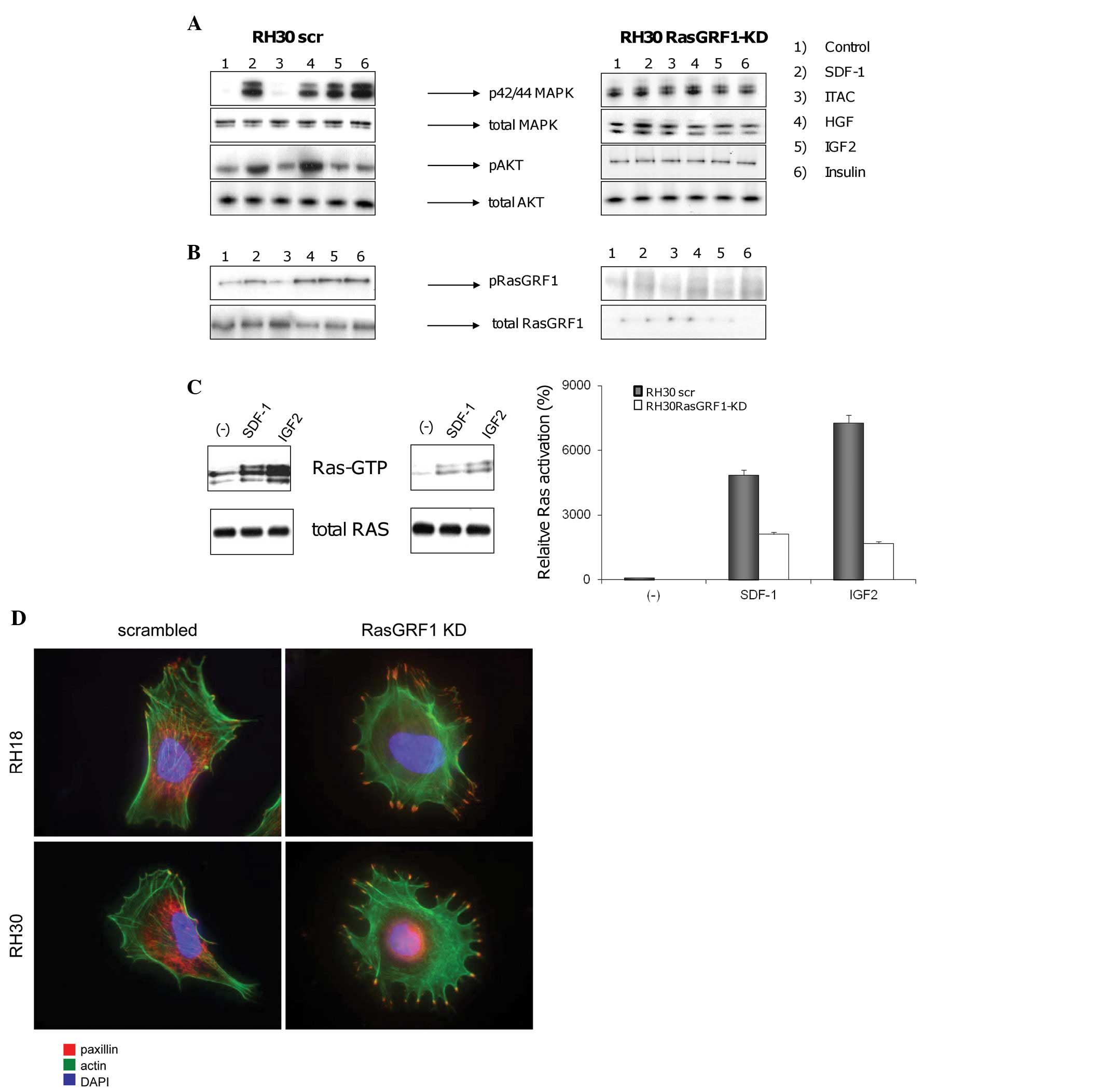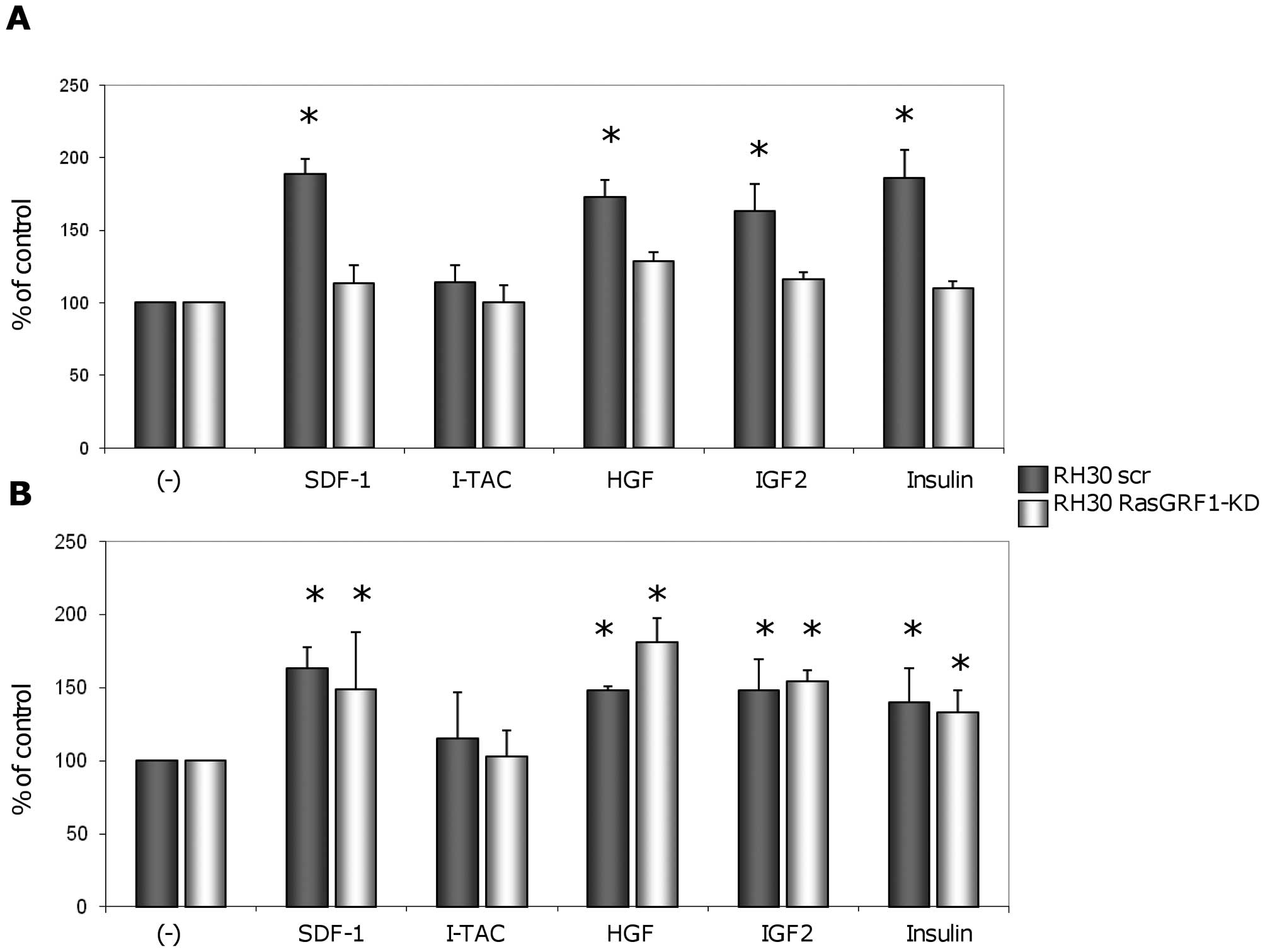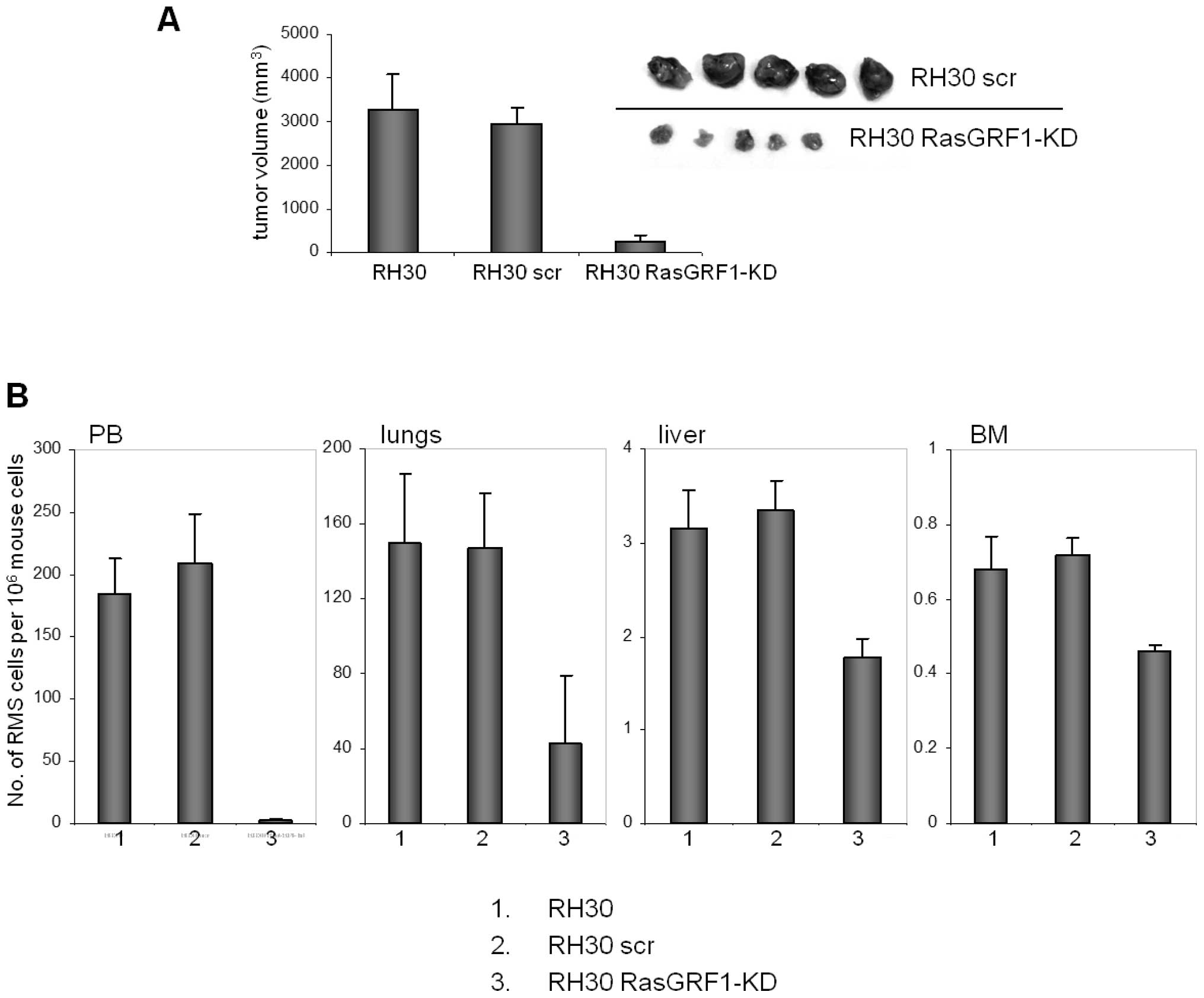|
1
|
Barr FG, Galili N, Holick J, Biegel JA,
Rovera G and Emanuel BS: Rearrangement of the PAX3 paired box gene
in the paediatric solid tumour alveolar rhabdomyosarcoma. Nat
Genet. 3:113–117. 1993. View Article : Google Scholar : PubMed/NCBI
|
|
2
|
Collins MH, Zhao H, Womer RB and Barr FG:
Proliferative and apoptotic differences between alveolar
rhabdomyosarcoma subtypes: a comparative study of tumors containing
PAX3-FKHR or PAX7-FKHR gene fusions. Med Pediatr Oncol. 37:83–89.
2001. View
Article : Google Scholar
|
|
3
|
Hazelton BJ, Houghton JA, Parham DM, et
al: Characterization of cell lines derived from xenografts of
childhood rhabdomyosarcoma. Cancer Res. 47:4501–4507.
1987.PubMed/NCBI
|
|
4
|
Kelly KM, Womer RB and Barr FG: PAX3-FKHR
and PAX7-FKHR gene fusions in rhabdomyosarcoma. J Pediatr Hematol
Oncol. 20:517–518. 1998. View Article : Google Scholar : PubMed/NCBI
|
|
5
|
Sandberg AA, Stone JF, Czarnecki L and
Cohen JD: Hematologic masquerade of rhabdomyosarcoma. Am J Hematol.
68:51–57. 2001. View
Article : Google Scholar : PubMed/NCBI
|
|
6
|
Sharp R, Recio JA, Jhappan C, et al:
Synergism between INK4a/ARF inactivation and aberrant HGF/SF
signaling in rhabdomyosarcomagenesis. Nat Med. 8:1276–1280. 2002.
View Article : Google Scholar : PubMed/NCBI
|
|
7
|
Gordon T, McManus A, Anderson J, et al:
Cytogenetic abnormalities in 42 rhabdomyosarcoma: a United Kingdom
Cancer Cytogenetics Group Study. Med Pediatr Oncol. 36:259–267.
2001. View Article : Google Scholar : PubMed/NCBI
|
|
8
|
Charytonowicz E, Cordon-Cardo C,
Matushansky I and Ziman M: Alveolar rhabdomyosarcoma: is the cell
of origin a mesenchymal stem cell? Cancer Lett. 279:126–136. 2009.
View Article : Google Scholar : PubMed/NCBI
|
|
9
|
Hahn H, Wojnowski L, Specht K, et al:
Patched target Igf2 is indispensable for the formation of
medulloblastoma and rhabdomyosarcoma. J Biol Chem. 275:28341–28344.
2000. View Article : Google Scholar : PubMed/NCBI
|
|
10
|
Makawita S, Ho M, Durbin AD, Thorner PS,
Malkin D and Somers GR: Expression of insulin-like growth factor
pathway proteins in rhabdomyosarcoma: IGF-2 expression is
associated with translocation-negative tumors. Pediatr Dev Pathol.
12:127–135. 2009. View Article : Google Scholar : PubMed/NCBI
|
|
11
|
Rikhof B, De Jong S, Suurmeijer AJ, Meijer
C and van der Graaf WT: The insulin-like growth factor system and
sarcomas. J Pathol. 217:469–482. 2009. View Article : Google Scholar : PubMed/NCBI
|
|
12
|
Wang W, Kumar P, Epstein J, Helman L,
Moore JV and Kumar S: Insulin-like growth factor II and PAX3-FKHR
cooperate in the oncogenesis of rhabdomyosarcoma. Cancer Res.
58:4426–4433. 1998.PubMed/NCBI
|
|
13
|
Naini S, Etheridge KT, Adam SJ, et al:
Defining the cooperative genetic changes that temporally drive
alveolar rhabdomyosarcoma. Cancer Res. 68:9583–9588. 2008.
View Article : Google Scholar : PubMed/NCBI
|
|
14
|
Innocenti M, Zippel R, Brambilla R and
Sturani E: CDC25(Mm)/Ras-GRF1 regulates both Ras and Rac signaling
pathways. FEBS Lett. 460:357–362. 1999. View Article : Google Scholar : PubMed/NCBI
|
|
15
|
Lavagni P, Indrigo M, Colombo G, et al:
Identification of novel RasGRF1 interacting partners by large-scale
proteomic analysis. J Mol Neurosci. 37:212–224. 2009. View Article : Google Scholar : PubMed/NCBI
|
|
16
|
Rossman KL, Der CJ and Sondek J: GEF means
go: turning on RHO GTPases with guanine nucleotide-exchange
factors. Nat Rev Mol Cell Biol. 6:167–180. 2005. View Article : Google Scholar : PubMed/NCBI
|
|
17
|
Langenau DM, Keefe MD, Storer NY, et al:
Effects of RAS on the genesis of embryonal rhabdomyosarcoma. Genes
Dev. 21:1382–1395. 2007. View Article : Google Scholar : PubMed/NCBI
|
|
18
|
Shome D, Honavar SG, Reddy VA and
Vemuganti GK: Orbital embryonal rhabdomyosarcoma in association
with neurofibromatosis type 1. Ophthal Plast Reconstr Surg.
23:147–148. 2007. View Article : Google Scholar : PubMed/NCBI
|
|
19
|
Yang P, Grufferman S, Khoury MJ, et al:
Association of childhood rhabdomyosarcoma with neurofibromatosis
type I and birth defects. Genet Epidemiol. 12:467–474. 1995.
View Article : Google Scholar : PubMed/NCBI
|
|
20
|
Jung A, Bechthold S, Pfluger T, Renner C
and Ehrt O: Orbital rhabdomyosarcoma in Noonan syndrome. J Pediatr
Hematol Oncol. 25:330–332. 2003. View Article : Google Scholar : PubMed/NCBI
|
|
21
|
Khan S, McDowell H, Upadhyaya M and Fryer
A: Vaginal rhabdomyosarcoma in a patient with Noonan syndrome. J
Med Genet. 32:743–745. 1995. View Article : Google Scholar : PubMed/NCBI
|
|
22
|
Gripp KW, Scott CI Jr, Nicholson L, et al:
Five additional Costello syndrome patients with rhabdomyosarcoma:
proposal for a tumor screening protocol. Am J Med Genet. 108:80–87.
2002. View Article : Google Scholar : PubMed/NCBI
|
|
23
|
Feingold M: Costello syndrome and
rhabdomyosarcoma. J Med Genet. 36:582–583. 1999.PubMed/NCBI
|
|
24
|
O’Neal JP, Ramdas J, Wood WE and
Pellitteri PK: Parameningeal rhabdomyosarcoma in a patient with
Costello syndrome. J Pediatr Hematol Oncol. 26:389–392. 2004.
|
|
25
|
Tidyman WE and Rauen KA: The RASopathies:
developmental syndromes of Ras/MAPK pathway dysregulation. Curr
Opin Genet Dev. 19:230–236. 2009. View Article : Google Scholar : PubMed/NCBI
|
|
26
|
Hettmer S and Wagers AJ: Muscling in:
uncovering the origins of rhabdomyosarcoma. Nat Med. 16:171–173.
2010. View Article : Google Scholar : PubMed/NCBI
|
|
27
|
Shin DM, Zuba-Surma EK, Wu W, et al: Novel
epigenetic mechanisms that control pluripotency and quiescence of
adult bone marrow-derived Oct4(+) very small embryonic-like stem
cells. Leukemia. 23:2042–2051. 2009.PubMed/NCBI
|
|
28
|
Stratton MR, Fisher C, Gusterson BA and
Cooper CS: Detection of point mutations in N-ras and K-ras genes of
human embryonal rhabdomyosarcomas using oligonucleotide probes and
the polymerase chain reaction. Cancer Res. 49:6324–6327. 1989.
|
|
29
|
Ren YX, Finckenstein FG, Abdueva DA, et
al: Mouse mesenchymal stem cells expressing PAX-FKHR form alveolar
rhabdomyosarcomas by cooperating with secondary mutations. Cancer
Res. 68:6587–6597. 2008. View Article : Google Scholar : PubMed/NCBI
|
|
30
|
Libura J, Drukala J, Majka M, et al:
CXCR4-SDF-1 signaling is active in rhabdomyosarcoma cells and
regulates locomotion, chemotaxis, and adhesion. Blood.
100:2597–2606. 2002. View Article : Google Scholar : PubMed/NCBI
|
|
31
|
Jankowski K, Kucia M, Wysoczynski M, et
al: Both hepatocyte growth factor (HGF) and stromal-derived
factor-1 regulate the metastatic behavior of human rhabdomyosarcoma
cells, but only HGF enhances their resistance to radiochemotherapy.
Cancer Res. 63:7926–7935. 2003.
|
|
32
|
Grymula K, Tarnowski M, Wysoczynski M, et
al: Overlapping and distinct role of CXCR7-SDF-1/ITAC and
CXCR4-SDF-1 axes in regulating metastatic behavior of human
rhabdomyosarcomas. Int J Cancer. 127:2554–2568. 2010. View Article : Google Scholar : PubMed/NCBI
|
|
33
|
Tarnowski M, Grymula K, Reca R, et al:
Regulation of expression of stromal-derived factor-1 receptors:
CXCR4 and CXCR7 in human rhabdomyosarcomas. Mol Cancer Res. 8:1–14.
2010. View Article : Google Scholar : PubMed/NCBI
|
|
34
|
Ratajczak MZ, Shin DM, Liu R, et al:
Epiblast/germ line hypothesis of cancer development revisited:
lesson from the presence of Oct-4+ cells in adult
tissues. Stem Cell Rev. 6:307–316. 2010. View Article : Google Scholar : PubMed/NCBI
|
|
35
|
Casola S, Pedone PV, Cavazzana AO, et al:
Expression and parental imprinting of the H19 gene in human
rhabdomyosarcoma. Oncogene. 14:1503–1510. 1997. View Article : Google Scholar : PubMed/NCBI
|
|
36
|
Anderson J, Gordon A, McManus A, Shipley J
and Pritchard-Jones K: Disruption of imprinted genes at chromosome
region 11p15.5 in paediatric rhabdomyosarcoma. Neoplasia.
1:340–348. 1999. View Article : Google Scholar : PubMed/NCBI
|
|
37
|
Scrable H, Cavenee W, Ghavimi F, Lovell M,
Morgan K and Sapienza C: A model for embryonal rhabdomyosarcoma
tumorigenesis that involves genome imprinting. Proc Natl Acad Sci
USA. 86:7480–7484. 1989. View Article : Google Scholar : PubMed/NCBI
|
|
38
|
Zhan S, Shapiro DN and Helman LJ:
Activation of an imprinted allele of the insulin-like growth factor
II gene implicated in rhabdomyosarcoma. J Clin Invest. 94:445–448.
1994. View Article : Google Scholar : PubMed/NCBI
|
|
39
|
Taichman RS, Wang Z, Shiozawa Y, et al:
Prospective identification and skeletal localization of cells
capable of multilineage differentiation in vivo. Stem Cells Dev.
19:1557–1570. 2010. View Article : Google Scholar : PubMed/NCBI
|
|
40
|
De la Puente A, Hall J, Wu YZ, et al:
Structural characterization of Rasgrf1 and a novel linked imprinted
locus. Gene. 291:287–297. 2002.PubMed/NCBI
|
|
41
|
Yoon B, Herman H, Hu B, et al: Rasgrf1
imprinting is regulated by a CTCF-dependent methylation-sensitive
enhancer blocker. Mol Cell Biol. 25:11184–11190. 2005. View Article : Google Scholar : PubMed/NCBI
|
|
42
|
Yoon BJ, Herman H, Sikora A, Smith LT,
Plass C and Soloway PD: Regulation of DNA methylation of Rasgrf1.
Nat Genet. 30:92–96. 2002. View
Article : Google Scholar : PubMed/NCBI
|
|
43
|
Martegani E, Vanoni M, Zippel R, et al:
Cloning by functional complementation of a mouse cDNA encoding a
homologue of CDC25, a Saccharomyces cerevisiae RAS activator. EMBO
J. 11:2151–2157. 1992.PubMed/NCBI
|
|
44
|
Buchsbaum R, Telliez JB, Goonesekera S and
Feig LA: The N-terminal pleckstrin, coiled-coil, and IQ domains of
the exchange factor Ras-GRF act cooperatively to facilitate
activation by calcium. Mol Cell Biol. 16:4888–4896. 1996.PubMed/NCBI
|
|
45
|
Chevallier-Multon MC, Schweighoffer F,
Barlat I, et al: Saccharomyces cerevisiae CDC25 (1028–1589) is a
guanine nucleotide releasing factor for mammalian ras proteins and
is oncogenic in NIH3T3 cells. J Biol Chem. 268:11113–11118.
1993.PubMed/NCBI
|
|
46
|
Leaner VD, Donninger H, Ellis CA, Clark GJ
and Birrer MJ: p75-Ras-GRF1 is a c-Jun/AP-1 target protein: its up
regulation results in increased Ras activity and is necessary for
c-Jun-induced nonadherent growth of Rat1a cells. Mol Cell Biol.
25:3324–3337. 2005. View Article : Google Scholar : PubMed/NCBI
|
|
47
|
Font de Mora J, Esteban LM, Burks DJ, et
al: Ras-GRF1 signaling is required for normal beta-cell development
and glucose homeostasis. EMBO J. 22:3039–3049. 2003.PubMed/NCBI
|
|
48
|
Guerrero C, Rojas JM, Chedid M, et al:
Expression of alternative forms of Ras exchange factors GRF and
SOS1 in different human tissues and cell lines. Oncogene.
12:1097–1107. 1996.PubMed/NCBI
|
|
49
|
Forlani G, Baldassa S, Lavagni P, Sturani
E and Zippel R: The guanine nucleotide exchange factor RasGRF1
directly binds microtubules via DHPH2-mediated interaction. FEBS J.
273:2127–2138. 2006. View Article : Google Scholar : PubMed/NCBI
|
|
50
|
Arozarena I, Matallanas D, Berciano MT, et
al: Activation of H-Ras in the endoplasmic reticulum by the RasGRF
family guanine nucleotide exchange factors. Mol Cell Biol.
24:1516–1530. 2004. View Article : Google Scholar : PubMed/NCBI
|



